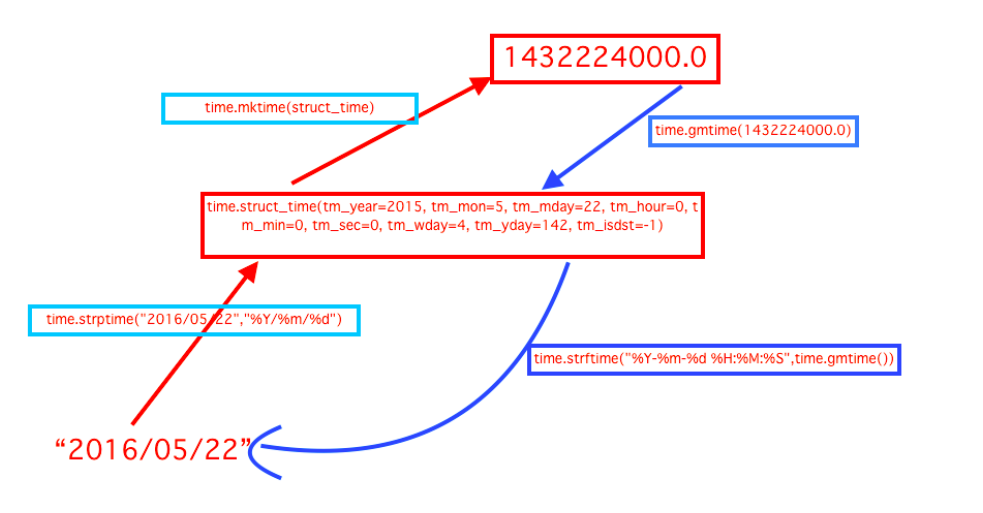time 模块
在平常的代码中,我们常常需要与时间打交道。在Python中,常用的与时间处理有关的模块就包括:time,datetime,下面来介绍time模块。
在开始之前,首先要说明几点:
一、在Python中,通常有这几种方式来表示时间:
- 时间戳
- 格式化的时间字符串
- 元组(struct_time)共九个元素。由于Python的time模块实现主要调用C库,所以各个平台可能有所不同。
二、几个定义
UTC(Coordinated Universal Time,世界协调时)亦即格林威治天文时间,世界标准时间。在中国为UTC+8。DST(Daylight Saving Time)即夏令时。
时间戳(timestamp)的方式:通常来说,时间戳表示的是从1970年1月1日00:00:00开始按秒计算的偏移量。我们运行“type(time.time())”,返回的是float类型。
元组(struct_time)方式:struct_time元组共有9个元素,返回struct_time的函数主要有gmtime(),localtime(),strptime()。下面列出这种方式元组中的几个元素:
索引(Index) 属性(Attribute) 值(Values) 0 tm_year(年) 比如2011 1 tm_mon(月) 1 - 12 2 tm_mday(日) 1 - 31 3 tm_hour(时) 0 - 23 4 tm_min(分) 0 - 59 5 tm_sec(秒) 0 - 61 6 tm_wday(weekday) 0 - 6(0表示周日) 7 tm_yday(一年中的第几天) 1 - 366 8 tm_isdst(是否是夏令时) 默认为-1
time模块的方法
- time.localtime([secs]):将一个时间戳转换为当前时区的struct_time。secs参数未提供,则以当前时间为准。
- time.gmtime([secs]):和localtime()方法类似,gmtime()方法是将一个时间戳转换为UTC时区(0时区)的struct_time。
- time.time():返回当前时间的时间戳。
- time.mktime(t):将一个struct_time转化为时间戳。
- time.sleep(secs):线程推迟指定的时间运行。单位为秒。
- time.asctime([t]):把一个表示时间的元组或者struct_time表示为这种形式:'Sun Oct 1 12:04:38 2017'。如果没有参数,将会将time.localtime()作为参数传入。
- time.ctime([secs]):把一个时间戳(按秒计算的浮点数)转化为time.asctime()的形式。如果参数未给或者为None的时候,将会默认time.time()为参数。它的作用相当于time.asctime(time.localtime(secs))。
-
time.strftime(format[, t]):把一个代表时间的元组或者struct_time(如由time.localtime()和time.gmtime()返回)转化为格式化的时间字符串。如果t未指定,将传入time.localtime()。
- 举例:time.strftime("%Y-%m-%d %X", time.localtime()) #输出'2017-10-01 12:14:23'
-
time.strptime(string[, format]):把一个格式化时间字符串转化为struct_time。实际上它和strftime()是逆操作。
- 举例:time.strptime('2017-10-3 17:54',"%Y-%m-%d %H:%M") #输出 time.struct_time(tm_year=2017, tm_mon=10, tm_mday=3, tm_hour=17, tm_min=54, tm_sec=0, tm_wday=1, tm_yday=276, tm_isdst=-1
-
字符串转时间格式对应表Meaning Notes %aLocale’s abbreviated weekday name. %ALocale’s full weekday name. %bLocale’s abbreviated month name. %BLocale’s full month name. %cLocale’s appropriate date and time representation. %dDay of the month as a decimal number [01,31]. %HHour (24-hour clock) as a decimal number [00,23]. %IHour (12-hour clock) as a decimal number [01,12]. %jDay of the year as a decimal number [001,366]. %mMonth as a decimal number [01,12]. %MMinute as a decimal number [00,59]. %pLocale’s equivalent of either AM or PM. (1) %SSecond as a decimal number [00,61]. (2) %UWeek number of the year (Sunday as the first day of the week) as a decimal number [00,53]. All days in a new year preceding the first Sunday are considered to be in week 0. (3) %wWeekday as a decimal number [0(Sunday),6]. %WWeek number of the year (Monday as the first day of the week) as a decimal number [00,53]. All days in a new year preceding the first Monday are considered to be in week 0. (3) %xLocale’s appropriate date representation. %XLocale’s appropriate time representation. %yYear without century as a decimal number [00,99]. %YYear with century as a decimal number. %zTime zone offset indicating a positive or negative time difference from UTC/GMT of the form +HHMM or -HHMM, where H represents decimal hour digits and M represents decimal minute digits [-23:59, +23:59]. %ZTime zone name (no characters if no time zone exists). %%A literal '%'character.
时间转换图片

来源:https://www.cnblogs.com/zivli/p/9615523.html